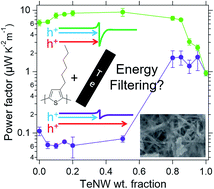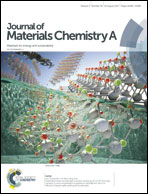Increased power factors of organic–inorganic nanocomposite thermoelectric materials and the role of energy filtering†
Abstract
Significant enhancements in the performance of organic–inorganic nanocomposite thermoelectrics may be obtained through appropriately adjusting energetics at the organic–inorganic interfaces. Through altering these interfacial energetics, the energy dependence of the electrical conductivity, and therefore the Seebeck coefficient, can in principle be readily manipulated through energy filtering. In this work, we controllably vary the energetic barrier between transport states in the conjugated polymer poly(3-hexylthiophene) and tellurium nanowires. The energetic barrier is adjusted from 0.08 to 0.88 eV by altering the concentration of the p-type dopant (FeCl3) present in the polymer phase. We show that the maximum power factors in these composites are increased beyond that of either the pure polymer or pure nanowires for barriers of both 0.08 and 0.88 eV. With both doping concentrations the Seebeck coefficient increases with the concentration of tellurium nanowires. Through comparison of the experimentally measured Seebeck coefficients with models for parallel and series connected composites, we determine that the enhanced Seebeck coefficients and power factors do not likely arise from energy filtering. Furthermore, we find that the electrical conductivity of the 5% FeCl3 doped blend can exceed that of either of the pure components by nearly an order of magnitude.



 Please wait while we load your content...
Please wait while we load your content...